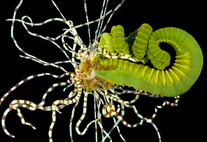Abstract
Morphological investigation into the paleate genus Paleanotus Schmarda 1861 of the family Chrysopetalidae from northern Australian coral reefs, primarily Lizard Island and outlying reefs, included a complex of very small, slender individuals (length < 5 mm). This complex resolved into 7 new species, described herein: Paleanotus inornatus n. sp., P. adornatus n. sp., P. chrysos n. sp., P. aquifolia n. sp., P. latifolia n. sp., P. silus n. sp., and P. silopsis n. sp. A key is provided to the new species and Paleanotus distinguished from Treptopale and Hyalopale, two closely related genera. Diagnostic features of the apical structure and shape of the notochaetal main paleae plus median paleae shape and raised rib pattern, differentiates each species from the other. Gametous states are described. Two cryptic species pairs (Paleanotus silopsis n. sp. and P. silus n. sp.; Paleanotus aquifolia n. sp. and P. latifolia n. sp.) were identified. In each case one species is restricted to either the NE or NW Australian coast. In each pair the most eastern point for the NW Australian species range occurs at Darwin, western Arnhemland, Northern Territory. Additional material for each species pair extends their respective ranges northwards: NW Australia to Thailand, Andaman Sea, eastern Indian Ocean or NE Australia, Great Barrier Reef to the Philippines, western Pacific Ocean. Cryptic morphology and potential genetic diversity is discussed in Paleanotus inornatus n. sp. and P. adornatus n. sp. that possess overlapping widespread distribution patterns across northern Australia and Indo-Pacific reefs. The smallest bodied taxon, Paleanotus chrysos n. sp. is the only species with a Coral Sea range encompassing Lizard Island, Heron Island and New Caledonia.

